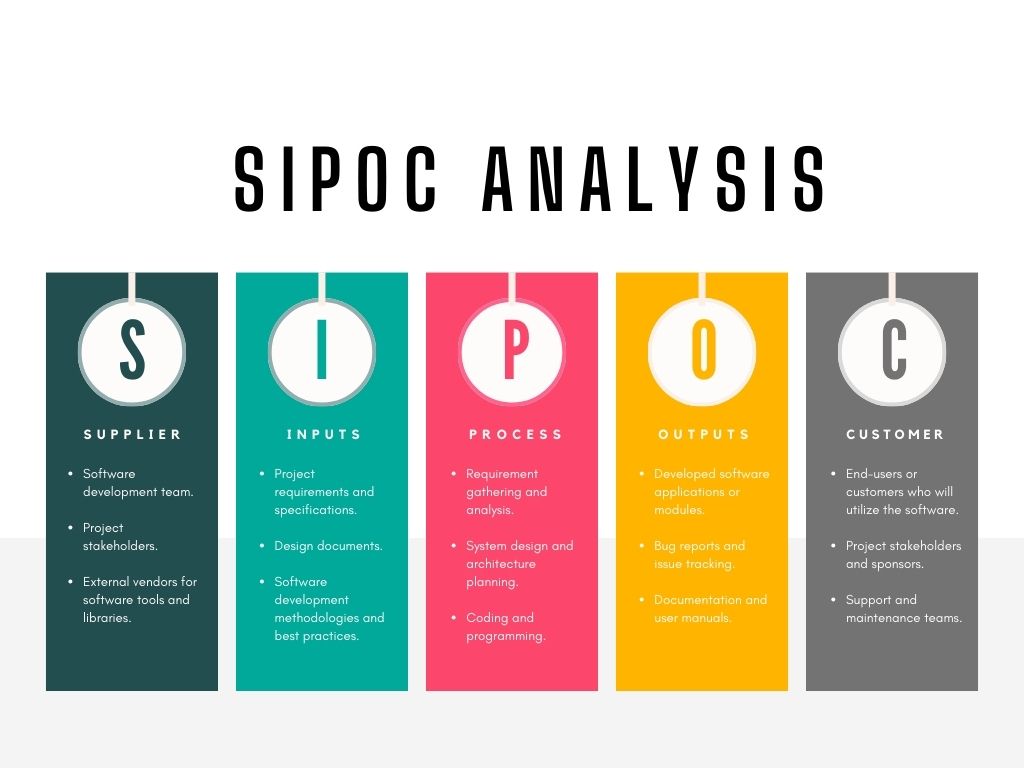Project management is one area where SIPOC analysis can be a beneficial tool to use. It helps in defining the project or process’ scope as well as understanding it. A framework that is organized for identifying key elements and stakeholders engaged in providing a service or product is what constitutes the SIPOC analysis. The fundamentals of this extensive guide include what three words stand for, their importance in helping project managers, and how they can apply them successfully in different projects.
What is SIPOC Analysis?
SIPOC stands for Suppliers, Inputs, Processes, Outputs, and Customers. This mapping tool represents graphically all stakeholders and constituents that are involved in the process. To understand each part better here are the breakdowns:
Suppliers: These are parties who offer inputs necessary to commence the process.
Inputs: These are resources provided by suppliers like materials or information without which a company cannot operate.
Process: This is an arrangement of activities through which inputs are transformed into outputs.
Outputs: The results of any process such as products, services, or deliverables made by it.
Customers: Who receives the outputs of a process?
Importance of SIPOC Analysis to Project Managers
SIPOC analysis is an advantage to project managers in several ways:
Scope Clarity: Scope boundaries and definitions for their projects are made clear through SIPOC Analysis by the project managers. It determines where a process starts (suppliers) and ends (customers), which ensures the roles and responsibilities of all stakeholders are well understood.
Stakeholder Identification: The mapping of suppliers, inputs, and customers enables project managers to identify every relevant stakeholder involved in the project. This awareness is critical for effective communication, collaboration, and managing stakeholders throughout the life cycle of the project.
Process Understanding: A structured summary of a process flow that reveals key steps as well as interdependencies can be obtained through SIPOC Analysis. By doing this, a project manager can spot possible bottlenecks, inefficiencies, or areas that can be improved upon.
Alignment on Objectives: Through defining inputs and outputs; SIPOC leads to coherence between desired results from a particular project vis-à-vis its goals. It aids in prioritizing tasks as well as resources by project managers towards realizing the achievement of stated objectives.
Facilitating Process Improvement: Continuous improvement programs are rooted in SIPOC analysis.
To do this, project managers should look at the whole process and its constituents, to recognize possibilities for making it simpler, better quality, and more resourceful.
Conducting SIPOC Analysis
Here is how you can effectively conduct SIPOC analysis:
Step 1: Identifying the Process Scope
Specify exactly what process or project you are interested in analyzing. Clearly state the limits of the study or the research.
Step 2: Gather a Cross-Functional Team
Assemble various stakeholders who understand this process. Make sure that suppliers, process owners, and customer-facing roles are involved.
Step 3: Mapping SIPOC Elements
Use sticky notes or a whiteboard to think through and represent these five things – suppliers, inputs, processes steps, outputs as well as customers on the SIPOC diagram.
Step 4: Validate and Refine
Ensure that all elements are captured correctly when reviewing the team’s copy of the SIPOC diagram. Verify each component while accepting changes informed by feedback plus new ideas.
Step 5: Analyze and Identify Gaps or Opportunities
Study your SIPOC diagram to find any weaknesses in your system that could be there through inefficiencies or even advancement opportunities. Look out for interrelationships among different players in terms of activities carried out at each stage.
Step 6: Record and Share Discoveries
The completed SIPOC diagram, along with significant insights, findings, and action items should be documented. The stakeholders and other members of the project team should be let in on this for clarity.
Uses of SIPOC Analysis
SIPOC analysis can be employed in several cases regarding project management:
New Project Kickoff: Start with a SIPOC analysis to determine what is included in the scope of the project as well as the key deliverables and stakeholders.
Process Improvement Initiatives: Identify existing process inefficiencies or bottlenecks and develop strategies for improvement.
Change Management: Identify possible risks arising from suppliers, inputs, processes, outputs, or customers resulting from changes proposed thus ensuring a smooth changeover process.
Risk Management: Use SIPOC analysis to identify potential risks associated with suppliers, process steps, or customer requirements.
Challenges and Considerations
Despite its advantages, some challenges come with SIPOC analysis such as-
Availability of Data: Getting accurate information that is up-to-date from stakeholders and data sources.
Complex Processes: Managing complexity in processes that involve multiple suppliers, inputs, or customer segments.
Handling Complex Processes: Handling intricate procedures including several suppliers, inputs, or clientele groups.
Keeping Things Relevant: SIPOC diagrams should be reviewed and updated regularly to account for modifications in stakeholder requirements or project scope.
In summary
Project managers may identify stakeholders, drive process improvements, define project scope, and comprehend process flows with the help of SIPOC analysis. Throughout the project lifecycle, project managers can improve efficiency, clarity, and alignment by utilizing SIPOC analysis successfully. Add SIPOC analysis to your toolkit for project management to empower your teams, reduce risks, and complete projects by 2024 and beyond.
Views: 0




Leave a Reply